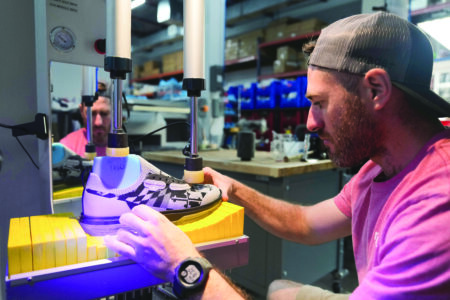Arts making comeback in schools
LEBANON, Pa. (AP) — STEM (science, technology, engineering and math) became education’s most popular buzzword in the past decade, and with education resources going to STEM, it left some arts advocates out in the cold.
Now, educators are slipping the arts back in by emphasizing the importance of creativity in science and engineering. They call it STEAM – STEM with “Arts” added.
The concept has its detractors, both among science advocates and “art for art’s sake” purists. But in Lebanon County, it’s opened up exciting new opportunities for real-world education, from cleaning up Lebanon to creating working guitars
Kids need to be creative
For Palmyra technology education teacher Eric Beiler, the National Science Foundation’s STEM Guitar project was a start.
Students must pay $80 to take Beiler’s electric guitar-making class, but that covers the full cost of parts and students leave at the end of the semester with a functioning guitar. In the process, they learn engineering principles as they design the guitar, physics as they learn about wavelengths for tuning and intonation, and math as they make measurements to determine precise placement of the guitar’s frets.
But Beiler thought he could take the project a step further than its original STEM focus. He partnered with music teacher Andrew Spotts to create a combined class in which students also learned how better play the guitar under Spotts’ instruction.
It’s an example of the blended science and arts education that STEAM advocates say best prepares students to succeed.
“We got so focused on basics in education that we forgot kids need to be creative and innovative,” said Kathleen Bouch, a Pennsylvania STEM ambassador and an education, math and science methods instructor in the education department at Lebanon Valley College.
The STEAM concept was first pushed by the Rhode Island School of Design a few years ago, and has already made its way into Lebanon County schools. For example:
Annville-Cleona created a class specifically dedicated to STEAM for first through sixth grades. Teacher Katie Martin looks at what’s being taught in regular curriculum and develops projects that teach creativity, design and engineering principals, collaboration and teamwork. In one class period, third grade students were tasked with inventing a device to shelter a stuffed animal from the rain or move water for one container to another.
The Great Lebanon Community Project in 2016, which included various projects to improve the environment, was branded by Lebanon School District as a STEAM project.
Lebanon advertised its new Northwest Elementary School building as having a “STEAM focus,” including a courtyard with an educational pond for life science and biology lessons.
You might as well call it school
The STEAM movement isn’t without its critics, both on the science and arts sides. STEM supporters are afraid that adding arts could result in “watering down” the recent focus on science and math, while arts supporters worry that STEAM devalues art by making it serve practical engineering purposes, according to the Education Week Teacher newspaper.
There are also practical concerns about overloading the acronym – and according to Blouch, some educators want to throw in reading to create STREAM.
“If you’re going to add all of these other acronyms, you might as well call it school,” Beiler said.
Yet science and the arts need each other, whether schools brand it as STEAM or not, educators said. For example, students need to be able to draw to succeed in engineering.
“A picture’s worth a thousand words, so the ability to sketch is important,” said Annville-Cleona Secondary School teacher Ian Wilson, who teaches STEM-based Project Lead the Way classes.
On the arts side, the most in-demand jobs in the music industry are highly technical, said Palmyra Middle School science teacher and national STEM teacher ambassador Jeff Remington. Other artistic jobs like pyrotechnics and 3-D art often have STEM components, he added.
Also, schools don’t always integrate science and the arts when they talk about STEAM.
“(W)e use STEAM to demonstrate our belief and commitment that the arts are an important part of a well-rounded education,” Lebanon Assistant to the Superintendent Michael Murphy said.
Lebanon does work to develop hands-on STEM projects, such as helping the city find ways to remove litter from storm water drains.
Real-world focus
Advocates for both STEM and STEAM believe in emphasizing practical problem solving, even though they know that can come at the expense of traditional forms of education like memorizing facts.
“Do we really need to spend time on so many facts (that are) easily found on the internet?” Remington asked.
Blouch said there is still a basic level of knowledge people must have to apply their knowledge effectively, so she doesn’t expect schools to completely abandon traditional competencies and go to a complete STEAM format. Another challenge with the traditional educational model, however, is that it is hard to train students for future careers because the world is changing so rapidly.
“Some of the jobs aren’t even invented yet that kids are going to have when they graduate,” she said – making it more valuable to teach students how to think and solve problems.
Technology-based education can also help students learn basic facts more effectively, educators said. Annville-Cleona’s media center uses augmented reality smart phone programs and virtual reality goggles that give students a view of outer space, geographical formations, or the inside of a canon.
“You can actually visualize it on your phone and see what Australia looks like,” said Annville-Cleona sophomore Macrae Plummer.
“We could look in a book, but to actually, virtually experience (these things), they’re going to stick in your head,” agreed Annville-Cleona social studies teacher Joseph Heckard.
___
Online:
https://bit.ly/2xNN488
___
Information from: Lebanon Daily News, http://www.ldnews.com





